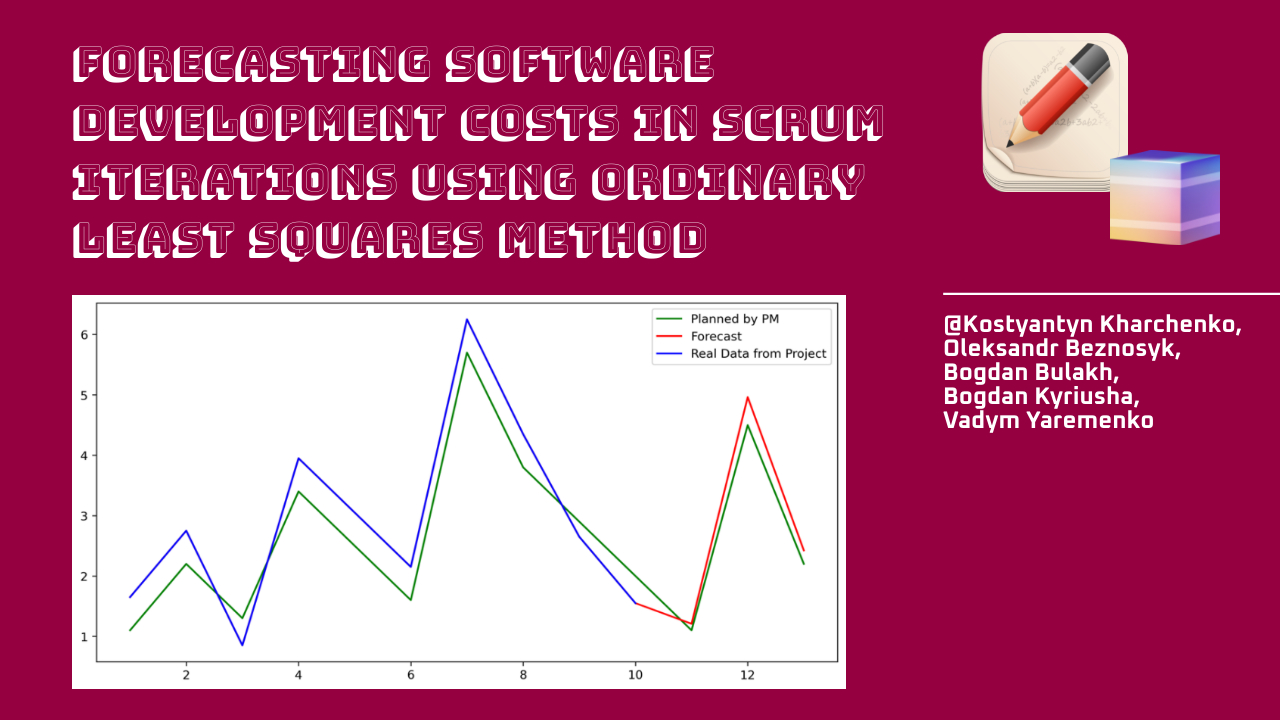Forecasting software development costs in scrum iterations using ordinary least squares method
DOI:
https://doi.org/10.15587/2706-5448.2024.310411Keywords:
cost forecasting, scrum, machine learning, least squares method, iterations, software developmentAbstract
During scrum iterations, it is possible to apply cost forecasting for software testing and operation, if the data from previous iterations are known. Since the data for estimating the scope of work and the deadline within one sprint are accumulated during the project execution, it is possible to use such data to build a forecasting algorithm for the estimated parameters of the subsequent sprints.
The approach is based on refining the assessment provided by the development team and the scrum master in a specific metric. The main parameters for evaluation are the execution time and the amount of work performed. As a result of forecasting, it is possible to obtain clarifications for the team's assessment regarding the scope of work for the next sprint. This estimate is based on planned and actual data from the previous sprints.
The article discusses the method of least squares and the proposed code for a machine learning model based on this method. An example and graphs for iterations in scrum and corresponding forecasting for the next sprints are presented.
The use of the least squares method allows creating a mathematical model that can be adapted to different project conditions, providing flexibility and accuracy in forecasting. For example, the study uses the real data from the previous sprints, which includes the team's resource assessment and actual expenditures. Based on these data, a model was built that demonstrates a high correlation between predicted and actual costs, confirming the effectiveness of using the least squares method.
So, the least squares method is an effective tool for forecasting software development costs in scrum iterations. This method allows development teams to better plan their resources and timelines, contributing to the overall efficiency of the project.
References
- Kharchenko, K., Beznosyk, O., Bulakh, B., Ishchenko, G., Yaremenko, V. (2023). The development of the method of optimizing costs for software testing in the Agile model. Technology Audit and Production Reserves, 6 (2 (74)), 10–14. https://doi.org/10.15587/2706-5448.2023.293067
- Sutherland, J., Schwaber, K. (2017). The Scrum Guide: The Definitive Guide to Scrum: The Rules of the Game. Available at: https://scrumguides.org/docs/scrumguide/v2017/2017-Scrum-Guide-US.pdf Last accessed: 05.06.2024
- Statistical models, hypothesis tests, and data exploration. Version 0.14.0. Available at: https://www.statsmodels.org/stable/ Last accessed: 01.06.2024
- Statsmodels. Ordinary Least Squares. Version 0.14.0. Available at: https://www.statsmodels.org/stable/generated/statsmodels.regression.linear_model.OLS.html Last accessed: 03.06.2024
- Ramessur, M. A., Nagowah, S. D. (2021). A predictive model to estimate effort in a sprint using machine learning techniques. International Journal of Information Technology, 13 (3), 1101–1110. https://doi.org/10.1007/s41870-021-00669-z
- Alshammari, F. H. (2022). Cost estimate in scrum project with the decision-based effort estimation technique. Soft Computing, 26 (20), 10993–11005. https://doi.org/10.1007/s00500-022-07352-w
- Coleman, J. (2022). Talking about Sizing and Forecasting in Scrum. Available at: https://www.infoq.com/articles/sizing-forecasting-scrum/ Last accessed: 05.06.2024
- Mallon, S. (2020). AI Advances Facilitate SCRUM Teams For Agile Development. Available at: https://www.smartdatacollective.com/ai-advances-facilitate-scrum-team-construction-for-agile-development/ Last accessed: 07.06.2024
- Omeyer, A. (2023). 4 ways Scrum Masters can Leverage AI today + tool recommendations. Available at: https://www.stepsize.com/blog/ways-scrum-masters-can-leverage-ai-today Last accessed: 10.06.2024
- Leveraging the Power of Artificial Intelligence in Agile Development (2023). Available at: https://www.cognixia.com/blog/leveraging-the-power-of-artificial-intelligence-in-agile-development/ Last accessed: 07.06.2024

Downloads
Published
How to Cite
Issue
Section
License
Copyright (c) 2024 Kostyantyn Kharchenko, Oleksandr Beznosyk, Bogdan Bulakh, Bogdan Kyriusha, Vadym Yaremenko

This work is licensed under a Creative Commons Attribution 4.0 International License.
The consolidation and conditions for the transfer of copyright (identification of authorship) is carried out in the License Agreement. In particular, the authors reserve the right to the authorship of their manuscript and transfer the first publication of this work to the journal under the terms of the Creative Commons CC BY license. At the same time, they have the right to conclude on their own additional agreements concerning the non-exclusive distribution of the work in the form in which it was published by this journal, but provided that the link to the first publication of the article in this journal is preserved.







